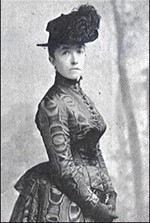March is Women in History Month - March 5, 2018
In 1987 the US Congress designated March as National Women’s History Month. This creates a special opportunity in our schools, our workplaces, and our communities to recognize and celebrate the often-overlooked achievements of American women. Each year there is a special Theme and women whose lives exemplify that theme are selected as National Honorees.
NEVERTHELESS SHE PERSISTED:
Honoring Women Who Fight All Forms of Discrimination Against Women
Geraldine Ferraro (1935-2011)
 Geraldine Ferraro was the first female vice-presidential candidate representing a major political party. Suffering multiple election defeats, she went on to serve as U.S. Ambassador to the United Nations Commission on Human Rights.
Geraldine Ferraro was the first female vice-presidential candidate representing a major political party. Suffering multiple election defeats, she went on to serve as U.S. Ambassador to the United Nations Commission on Human Rights.
Geraldine Ferraro first ran for public office in 1978 and was elected to the U.S. House of Representatives where she served three terms representing the 9th district of New York. Ferraro quickly rose in her party’s hierarchy where she was twice elected Secretary of the House Democratic Caucus. In Congress, she focused much of her energy on gender equity in wages, pensions, and retirement benefits.
As the 1984 presidential primary season drew to a close, women’s organizations including the National Organization for Women (NOW) and the National Women’s Political Caucus, put pressure on the frontrunner to select a woman for vice president. In July 1984 Walter Mondale announced his selection of Geraldine Ferraro as his running mate. She was both the first woman and first Italian American to run on a major party national ticket and her candidacy was celebrated by feminists and immigrant communities alike. Ferraro faced sexism on the campaign trail, reporters regularly asking if she was tough enough to serve as commander-in-chief. On November 6, 1984, Mondale and Ferraro lost the election. Despite the loss, Ferraro was seen as having a bright political future; she ran for Senate in 1992 and 98 but failed to advance past the Democratic primaries.
In 1993 President Clinton appointed Ferraro U.S. Ambassador to the United Nations on Human Rights and in 95 appointed her Vice-Chair of the U.S. delegation to the Fourth World Conference on Women in Beijing. In both roles, she served as an effective voice for women’s human rights around the world.
Despite being diagnosed with multiple myeloma in 1998, Geraldine Ferraro remained politically active serving as a news commentator and working on the historic Hillary Clinton for president campaign in 2008.
Isabella Stewart Gardner
Isabella Stewart Gardner (1840-1924)
 Isabella Stewart Gardner was a young married woman when she lived at 152 Beacon Street, an elegant townhouse-style mansion built in Boston’s newest and most fashionable neighborhood, the Back Bay. The house was a gift from her father on the occasion of her marriage in 1860, and it was here that Isabella and her husband, Jack Gardner, began to collect the impressive art collection that would one day comprise what we know as the Isabella Stewart Gardner Museum.
Isabella Stewart Gardner was a young married woman when she lived at 152 Beacon Street, an elegant townhouse-style mansion built in Boston’s newest and most fashionable neighborhood, the Back Bay. The house was a gift from her father on the occasion of her marriage in 1860, and it was here that Isabella and her husband, Jack Gardner, began to collect the impressive art collection that would one day comprise what we know as the Isabella Stewart Gardner Museum.
Isabella Stewart was born in New York City in 1840, the daughter of David Stewart, whose wealth was derived from Irish linen and mining investments, and Adelia Smith Stewart. The eldest of four children, Isabella was the only one to survive to adulthood and she was doted upon. She was proud of her paternal Scottish ancestry through the royal Stuart line and her mother’s English heritage that brought the Smiths to Boston in 1650 and then to Long Island. Isabella was educated at home by private tutors, attended private school in New York, and attended “finishing school” in Paris from 1856 to 1858.
According to a publication of the Gardner Museum, during Isabella’s two years in Paris, she traveled with her parents to Italy where she was first captivated by Renaissance art and architecture. Years later, Isabella’s friend Ida Agassiz Higginson would remind her, “You said to me … that if you inherited any money that it was yours to dispose of, you would have a house … like the one in Milan filled with beautiful pictures and objects of art, for people to come and enjoy.”
Returning home from this memorable trip to Europe, Isabella became engaged to John L. “Jack” Gardner, the brother of her Paris classmate Julia Gardner. The Gardners’ impressive wealth was derived from the Salem maritime trade, later, from investments in railroads, mines, and mills. Isabella and Jack moved to 152 Beacon Street in Boston after their marriage in New York, and within three years they were expecting their first child. Sadly, their son, “Jackie,” died within two years from pneumonia. Isabella suffered a miscarriage soon after, and doctors advised the couple to travel abroad to restore Isabella’s health and spirits.
The Gardners journeyed to Scandinavia, Russia, Italy, and France, and Isabella’s “ebullient personality and zest for life” were restored, according to the Gardner Museum. The couple continued to travel over the next several years, including to unconventional places like Egypt, Nubia, Palestine, Athens, Vienna, Munich, and Nuremberg. Isabella’s travel journals reveal her keen interest in other cultures, their art, and architecture. Back home in Boston, Isabella (who was often referred to as “Mrs. Jack”) was attracting attention as a woman who was “eccentric,” “original,” the “leader of the smart set,” and “one of the seven wonders of Boston” — not at all what was expected of a proper Victorian Boston lady.
Through her travels abroad and acquaintances in Boston, Isabella was drawn into intellectual and artistic elite circles with the likes of Julia Ward Howe, Sarah Orne Jewett, Henry James, James McNeill Whistler, and F. Marion Crawford whose invitation for her to attend readings by Harvard’s Charles Eliot Norton led her to begin collecting rare books and manuscripts. Isabella held dinner parties, salons, and lectures in her Beacon Street home including talks by Edward Morse on Japanese art and culture, which inspired the Gardners to visit that country in 1883. They also traveled to China, India, and Egypt and befriended local artists. Their return visit to Venice in 1884 introduced Isabella to more artists who urged her to collect and advised her on what was important. The Gardners’ visit to London in 1886 led them to John Singer Sargent, who would play a significant role in Isabella’s life as her portraitist and protégé. By 1894, her ten-year relationship with Bernard Berenson had ripened into one of advisor and collector. The Gardners’ home at 152 Beacon Street was now packed full of glorious works of art from all over the world. According to the Gardner Museum, Isabella’s purchase of Rembrandt’s 1629 Self-Portrait is what finally inspired the Gardners to create a proper museum.
They chose The Fenway for its remote location, natural light, and for the new, beautifully landscaped park system created by Frederick Law Olmsted. They would create a Venetian palace, like those they had visited in Italy, with grand public rooms, an interior courtyard, and a private apartment for their use. Tragically, on December 10, 1898, Jack Gardner died suddenly of a stroke. Isabella would have to realize their dream on her own.
She threw herself into the project, directing every detail, climbing ladders to oversee installations or the painting of just the right color. She worked with some of her talented friends on room displays and garden plantings. On the evening of January 1, 1903, guests were invited to a private opening of Fenway Court, complete with a concert by members of the Boston Symphony Orchestra. Isabella Stewart Gardner’s museum opened to the public a month later in February; now, hundreds could enjoy more than 2,500 objects from ancient Egypt to Matisse including paintings, sculpture, drawings, prints, historical furniture, ceramics, glassware, books, and manuscripts. As her friend, Henry Adams wrote to her, “As long as such a work can be done, I will not despair of our age, though I do not think anyone else could have done it … You are a creator and stand alone.” To this day, as Isabella stipulated in her will, her public rooms remain exactly as she designed them.
In 1919, Isabella Gardner suffered a stroke that left her partially paralyzed but still able to visit and receive friends. She eventually died in 1924, leaving behind an extraordinary legacy of which Fenway Court, the Isabella Stewart Gardner Museum, is the most visible. But Isabella was also an extraordinarily generous patron of up-and-coming artists and musicians—a tradition carried on by the Gardner Museum today—whose works of art may be found in museums and collections all over the world. She also supported the Boston Symphony Orchestra, the Boston Zoo, hospitals, literary associations, and the Episcopal Church. Her will left sizable bequests to the Massachusetts Society for the Prevention of Cruelty to Children, the Industrial School for Crippled and Deformed Children, the Animal Rescue League, and the Massachusetts Society for the Prevention of Cruelty to Animals. She is buried at Mount Auburn Cemetery in Cambridge with her husband and infant son.
Her motto through life, which appears above the central portal of the Isabella Stewart Gardner Museum, was “C’est mon
* © National Women's History Project | P.O. Box 469, Santa Rosa, CA 95402
** Source – Boston Women’s Heritage Trail, Biographies by Bonnie Hurd Smith






